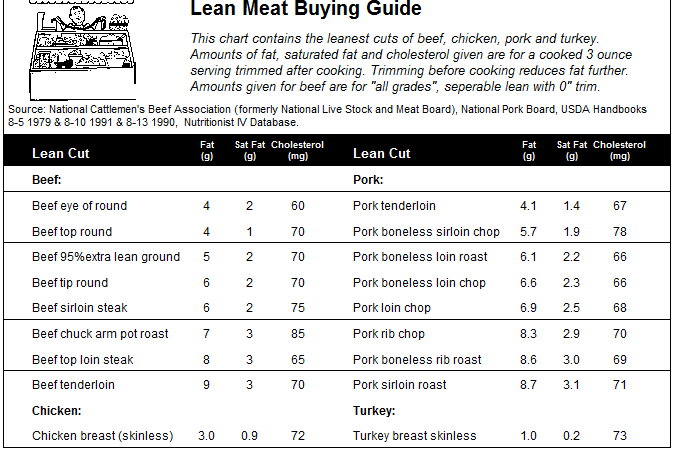Leaner Is Quicker
American consumers have more choices these days when it comes to purchasing lean cuts of meat and poultry. According to the National Cattlemen’s Beef Association, retail beef is 27% lower in fat and retail pork is 31% lower in fat today than in the early ’80s. This is a result of feeding, genetics, and management practices, in addition to greater external fat trimming. While all cuts are leaner than they used to be, certain cuts are leaner than others.Basic rules of thumb: Look for the words round or loin for beef, the word loin for pork, and breast for chicken or turkey. Trim all visible fat from beef and pork; remove skin and visible fat from chicken and turkey. Individual portion sizes should be kept to a maximum of 3.5 ounces (raw) per person or about the size of a deck of cards.Select a low-fat cooking method such as broiling, roasting on a rack (to let remaining fat drip away), and cooking with liquid or vegetable oil cooking spray in a nonstick skillet or stove-top grill pan. For best results when using lean meats in your spaghetti sauces, sloppy Joe’s, and stews, add them at the end and cook just until done.By purchasing leaner cuts of meat and keeping preparation methods the same you will lower the amount of saturated fat you consume, keeping your heart healthy. But there is another bonus! The number two advantage to using lean cuts of meat and poultry is the amount of time saved in meal preparation.Below we’ve listed the leanest and quickest-cooking cuts of meat and poultry along with suggestions on how to keep them moist and delicious.
- Turkey tenderloin is the boneless whole muscle from the center of the breast half, the leanest of all turkey cuts. One turkey tenderloin weighs about 12 ounces. Roast it whole with a glaze made from mustard and all-fruit preserves (or bbq sauce) then slice into medallions to serve. Internal temperature should be 160º or it should be firm and no longer pink in the center.
- Boneless sirloin pork chops are the second leanest cut of pork (tenderloin is first). Look for ones that are trimmed of visible fat and thinly sliced (½ inch). Try brushing chops with mustard and topping with plain bread crumbs before baking. Chops are done when firm and no longer pink in the center.
- Boneless, skinless chicken breast halves cook very quickly. Trim any visible fat and cook until firm and no longer pink in the center. Excessive cooking temperature (oven or grill too hot) and overcooking (cooking too long) yield dry meat. Bake with marinara or bbq sauce for a moist, flavorful quick entree.
- Round Tip Steak from the eye of the round or top round cooks very quickly. Select is the leanest grade with the choice being next to best; prime is the highest fat grade. These steaks are very thin- about ¼ inch thick. They cook quickly for sandwiches, fajitas, salads, stir-fries, and chili. Add towards the end of the recipe and cook until firm and no longer pink in the center.
Sources: National Cattleman’s Beef Association, National Pork Council, Applied Foodservice Sanitation.Buying GuideGrocery stores with a custom meat case usually contain the choice grades while the self-service budget counter usually contains select. Check the package labeling to be sure or ask the butcher. The best bet for lean ground beef is to purchase 95% extra-lean stated on the package.Chicken breast meat comes skinless, boneless, or skinless and boneless. Skinless and boneless cooks quicker and is more convenient. Roasting chicken with the skin on and removing it after it is cooked will yield a product that is moister with the same fat content as one cooked without the skin (according to researchers from the University of Minnesota); an exception is when the chicken is roasted over or with a sauce- the fat from the skin would drip into the sauce and increase the fat content of a dish significantly. The skin on a chicken breast adds 4-6 grams of fat per 3 ounces cooked portion. Check the sell-by date on the package to ensure freshness; chicken is good for 3 days after the sell-by date if properly refrigerated.Turkey breast products are offered in many different cuts: ground, cutlets, tenderloin, and whole. Fat content is always very low as long as packaging specifies skinless breast meat. Regular ground turkey with skin, breast, and dark meat contains 12-15 grams of fat per 3 ounces cooked portion- the same as lean ground beef.Pork doesn’t have grades, you have to go by the cut. Chops and roasts with the word loin are the leanest cuts of pork (less than 9 grams per 3-ounce cooked portion). Blade loin comes from nearest the shoulder while sirloin (the leanest) comes from nearest the leg. Tenderloin is the leanest of all pork cuts at only 4.1 grams of fat per 3-ounce cooked portion. 


